If you are a mom like me, you would know that a snotty-nosed baby can be one of the most frustrating experiences you can have as a parent.
It is painful to see our babies not being able to breathe properly—as they are nose breathers—and they are unable to feed from your breast or a bottle.
It’s not as if you can just pass your baby a box of tissues and a decongestant pill.
Fortunately, there nose suction options for babies and that’s what we are going to talk about in this post, and we will also walk you through some tips on how to find the best nose suction for babies.
Content:
- What is a Nose Suction?
- How does it work?
- Different Types of Nose Suction
- Choosing the Best Nose Suction Type for Your Baby
- Best Picks
- Can Nasal Aspirators Hurt the Baby?
What is a Nose Suction?
A nose suction or nasal aspirator is any small device that can draw snot from a baby’s nose to help him or her breathe easier.
It sucks the mucus out of the baby’s nasal passage via a bulb or a tube. It’s used when the baby’s nose is congested that their ability to breathe, sleep well and eat gets affected.
How does it work?
If you are using a nose suction for the first time, you may find it daunting because the tip may appear bigger than your baby’s nose. But with the right technique, it’s actually very easy.
You just have to use a small amount of nasal saline (which you can make at home with salt and water) to make the process a bit easier, as the saline solution helps in softening the mucus for faster suction.
It is important to note that before using a nasal aspirator, make sure to listen carefully to your baby’s breathing and ensure that the reason of the congestion is not fever.
If the breathing is fast and labored, or if the baby has a fever, call the doctor immediately.
Different Types of Nose Suction
There are several types of baby nose suction and it is a good idea to know more about each one before purchasing so that you will know which one is best for your baby.
1) Bulb Syringes
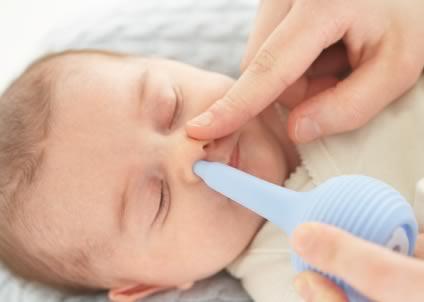
Also called bulb nasal aspirators, bulb aspirator or nose bulbs, this nose suction type is one of the most common types available.
It is usually made of rubber shaped like a large ball or bulb on one end, with a tapered tube attached to it that looks like an eye dropper.
This is what’s usually sent in your hospital discharge pack and are used by nurses and doctors, so you might think they are the best type.
Think again! First off, they are not designed for repeated use. If you cut the bulb open after one or two uses, it is highly likely that you’ll find mold inside the rubber bulb.
If you are looking for a cheap and disposable baby suction option, this one’s for you.
But keep in mind that they are difficult to clean, and the risk for mildew or mold (mentioning this again just for kicks) is quite high so I don’t recommend sticking it up your baby’s nose after the first use.
If you really want to save up on a few dollars, find a bulb nose suction that you can open up to view the inside and clean it.
Another thing to consider is its degree of suction, as it does not suck as well as other types of nasal aspirators. Suctioning thicker mucus might be problematic with this type.
Pros
- Very cheap
- Easily available
- Good for suctioning thin mucus
Cons
- Insufficient suction
- Disposable, not fit for multiple uses
- Difficult to clean
How To Use Bulb Syringe?
2) Oral Suction Aspirator
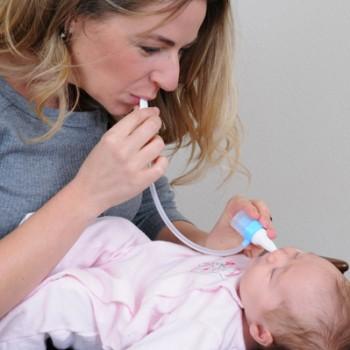
Also called as human suction aspirators, this type is parent or caregiver powered.
A tube is inserted in one of the baby’s nostril, and the other end then goes to your mouth so you can generate vacuum by sucking on the mouthpiece and get the baby boogers out.
Okaaay… don’t be grossed out just yet. These aspirators have filters that prevent you from inhaling the snot.
This thought may make you want to gag, but the filter or container collects the mucus so you won’t have to worry about snot entering your mouth.
Fortunately, there are aspirators like this, because if you must know, some people in other countries suck the snot directly from their baby’s noses.
Worried about germs? No need. The filter is specifically designed to prevent bacteria from entering your mouth, but it does not ensure that you will not get your baby’s cold, too.
But what makes this nose suction type great?
The main reason why many parents choose this type of nasal aspiration is the level of control it allows you in terms of suction.
You can regulate how hard or soft you suck the mucus out so that the little one remains comfortable during the process.
Pros
- Regulated suction control
- Very easy to clean
- Long-term use
- Can offer the most effective nasal decongesting solution for babies
Cons
- Requires a more hands-on process than other aspirators
- Can be icky for some
- You can possibly catch the same cold as your baby
How To Use The Oral Suction Aspirator?
3) Electric Nasal Aspirators
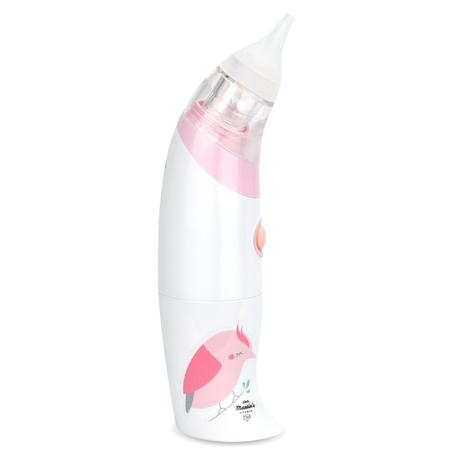
This is probably the best nose suction for babies choice for parents who want to get things done quickly, and, well, get grossed out by the other options mentioned above.
An electric nasal aspirator requires no sucking, squeezing and other laborious baby snot processes.
You simply just have to push the ON button, gently place it up your baby’s nose, and just wait for the mucus to drain. Yes. It is pretty easy.
What’s great about electric aspirators is that they provide continuous suction and works best for stubborn mucus and boogers. However, while the suction is constant, it is not as powered as oral suction aspirators.
The suction level also cannot be regulated and is limited to a safe level, which makes sense, because who knows, you might end up sucking your baby’s brains out of his or her nose.
Kidding aside, the weaker suction power is great for thin, runny nasal mucus. They often run on batteries; which is great, but you have to make sure the batteries are juiced up so you won’t be frustrated when they die on you while you are using the aspirator.
Pros
- Super easy to use
- Provides continuous suction
Cons
- Weaker suction
- The suction level cannot be regulated or adjusted
- Battery operated
Choosing the Best Nose Suction Type for Your Baby
Here are the factors you should pay attention to when buying a nasal aspirator:
Cleanable
It is normal for babies to have several runny nose episodes, so it is a good idea to buy a nose suction that can be easily cleaned to prevent mold and bacteria growth. Find ones that can be easily disassembled so that all parts can be easily cleaned.
Cleanable baby nose aspirators reduce risks of infections and eliminate mildew and mold buildup.
And because you can clean them, you can reuse these aspirators many times, which means that you save money from buying disposables every single time your baby gets a cold.
Materials
The different parts of the nasal aspirator that comes in contact with your baby’s nose should be made of materials that do not harbor bacterial growth. Those made of silicone are your best bet, as they are flexible and sanitary.
Nasal Tip Size
Your baby will grow quickly, so it is a good idea to choose a nasal aspirator that has interchangeable tips and can be used when your baby’s nostrils become a little larger.
Cleanable and interchangeable tips are great money savers because you won’t have to buy a new aspirator as your baby grows.
Suction strength
there are different kinds of congestion and your baby’s mucus consistency may change from one day to the next. Aside from this, you should also consider your baby’s tolerance to pain.
Just because it worked for my baby doesn’t mean it will work for you. So consider buying a baby nasal aspirator that allows you to adjust the level and strength of suction according to the snot consistency and your baby’s comfort.
Best Nose Suction for Babies
Type Product Satisfaction Rate
Best Bulb Syringe
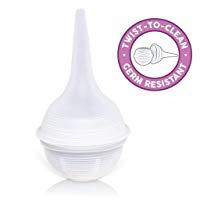
Best Oral Suction Aspirator
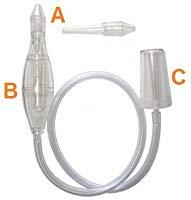
Best Electric Nasal Aspirator
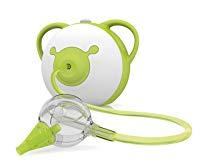
Can Nasal Aspirators Hurt the Baby?
Most babies will cry when you use a nasal aspirator on them because it may feel strange, uncomfortable and a bit painful for them.
It is effective, however, IF properly used. This said, you should be confident enough to use it knowing that an aspirator WILL NOT put your baby in danger or harm her/him.
Here are some important things to keep in mind:
#1 If you are using a bulb syringe, squeeze the air out of the bulb before putting the tube in your baby’s nose and DO NOT squeeze air while it is posed near the nasal cavity as this may harm your baby.
#2 When using saline drops to thin out snot, do so sparingly. Do not use them 3 days in a row so that your baby’s nasal passages do not dry out and get inflamed. And be mindful of the saline products that you use—make sure they are for babies.
#3 Using nasal aspirators on your baby more than 3 times in one day can irritate the sensitive and delicate tissues lining your baby’s nasal passage.
#4 Clean the baby nasal aspirator after every use so that bacteria and mold growth is eliminated. Dirty aspirators can cause infections and other illnesses, so this is a very important thing to remember. Read the package instructions that came from the manufacturer regarding cleaning, sanitizing and sterilizing the product.
#5 Do not thrust the other end aggressively up on the baby’s nose. Be mindful of the suction strength as overly aggressive suctioning can result to ruptured tissues and nosebleeds. Check the safety ridge delineation so you will know how far the aspirator syringe should go into the nostril.
Final Thoughts
Baby nasal aspirators can be a safe and effective tool to use for those periods when your baby’s nasal passages are congested as long as proper precautions are followed.
You will feel uneasy using one at first, but as you gain experience, you will be able to gauge your baby’s comfort level as well as the best process that will work for you both.
Finding the best nose suction for babies should involve research and due diligence, after all, you are nosing a device for one of your baby’s most sensitive body parts.
When you find the device that would work best for you and your baby, make sure that you check with your pediatrician and follow his/her advice regarding when to use it and how to use it.
Additional information:
- Baby Congested at Night: Causes and Treatment That Work
- Best Humidifiers for Babies (Moms’ Picks)
- How to Give Nasal Saline Drops
- How to Make Saline Nose Drops for Infants
- Runny Nose from a Cold: Does your child need antibiotics?
- Coughs and Colds: Medicines or Home Remedies?
- Influenza (flu) and your baby
Video credits: Baby Center, Eco Piggy, Little Martin’s Drawer, ramoz3000, The Baby Cubby.
